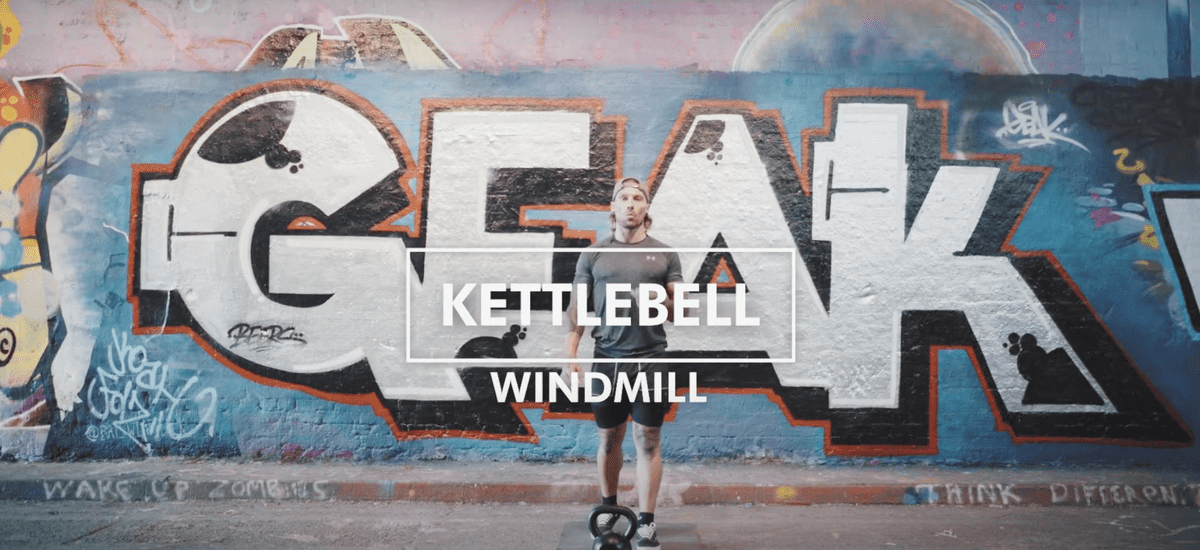Kettlebell Windmill
by Sam Franklin
How to Master The Kettlebell Windmill: Your Core & Flexibility Friend
The kettlebell windmill offers core strength training and effective body conditioning in one neat kettlebell exercise.
One of the best stability and mobility-based kettlebell movements around, the windmill is a must if you’re looking to become more supple or cross-training for activities including swimming, running, and team sports.
Here we’re going to look at the body-boosting benefits of the kettlebell windmill while showing you how to do it properly.
Let’s go.
How to do a kettlebell windmill: video tutorial
Before we dive into the benefits of kettlebell windmill, watch our quick tutorial video by Luke Baden, Kettlebell Master Trainer.
Luke will take you step by step through the entire movement, ensuring your form is correct and you get the absolute maximum out of the exercise.
The body-boosting benefits of the kettlebell windmill
Less of a strength training activity and more of a body conditioner, the kettlebell windmill is an exercise that will help with your everyday wellbeing while boosting your performance in other activities. Here are the main perks of performing the mighty windmill:
- Power & flex: The classic kettlebell windmill is a smooth controlled movement, meaning that it will significantly increase your hip strength while making your hamstrings flexible. This magic combination will make you far more stable and supple while safeguarding you from injury.
- Core strength: As the very foundation of your strength and fitness levels (and ultimately, progress), working on your core is vital. The kettlebell windmill is one of the best core-fortifying exercises of the kettlebell world, making it a pivotal part of any solid training session.
- Shoulder stability: The windmill places a strong focus on the shoulder area, increasing stability and mobility no end. Essential if you’re an athlete looking to optimise your performance or a sedentary worker searching for ways to keep your body in good shape.
What muscle groups does the kettlebell windmill work?
As a major flexibility-enhancing and core-building tool, the kettlebell windmill focuses on the mid and upper sections of the body. Here are the main muscle groups the kettlebell windmill works:
- Hamstrings: As a leg muscle group responsible for overall lower body resilience, working on your hamstring flexibility will enhance your other strength training exercise while protecting you from injury.
- Obliques: Found at the bottom left and right of your torso, your oblique muscles are linked to better core strength as well as mobility and as such, assist with posture. Working these muscles out will improve both sitting and standing posture while giving your core the boost it needs to succeed.
- Abdominals: As pivotal torso-based muscles, strengthing and conditioning your abs will fortifying your core while making you look good. Enough said.
- Rhomboids: Your rhomboids help to support your upper back and aid solid posture. Looking after your rhomboids will make your upper body stronger and more stable.
- Deltoids: As a vital shoulder-based muscle group, conditioning your deltoids is important if you want to make your upper body more mobile and as a result, more flexible.
Kettlebell windmill form tips
What to do
As a fairly advanced kettlebell exercise, getting your windmill form just right is essential if you want to reap maximum health and fitness rewards—and avoid injury, of course. These tips will steer you in the right direction:
- Foot positioning: Unlike many standing kettlebell exercises, your feet should be slightly less than shoulder-width apart with each foot pointing around 45 degrees out in opposite directions. One foot should be positioned slightly behind the other.
- Hip loading: Place the majority of your body weight on your rear hip, picking up the kettlebell with a straight arm. Lifting the kettlebell above shoulder height, at a roughly 45-degree angle, shift the weight more towards your front hip. Perform this movement slowly while keeping your eyes on the kettlebell with your arms extended.
- The dip: Keeping your eyes locked up at the extended kettlebell, slide your free arm towards the floor slowly in a smooth movement as far as you can comfortably go, remaining in position.
- The rise: Perform the movement in reverse, again using a slow, steady action until you reach an upright position—and repeat. Perform equal amounts of reps on both sides of the body.
What to avoid
If you get the kettlebell right it will work wonders. Get it wrong and it could spell disaster. To ensure you do get it right, here’s what to avoid when performing a windmill:
- Don’t perform the activity using sudden pulling or jerking movements. Not only will this render your windmills useless but it could also result in a muscle tear.
- Don’t overextend into your dip too much if you’re new to kettlebell training. Focus on getting the movement just right, going slightly lower over time until you can touch the floor with your free hand.
- Don’t go too heavy too early. Instead, choose your kettlebell size wisely, using heavier weights incrementally as your strength and flexibility improve.
Related kettlebell windmill exercises
To maximise your kettlebell sessions and complement your windmills, here are three related exercises you should look into:
- Kettlebell row
- Kettlebell high pull
- Kettlebell clean
